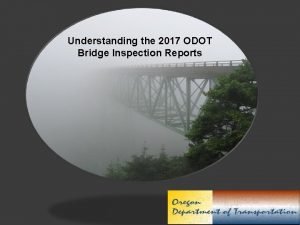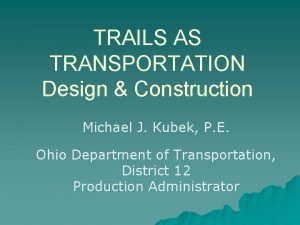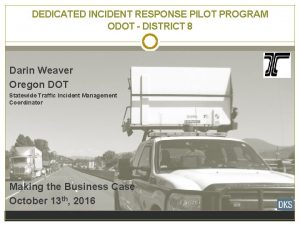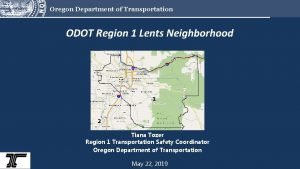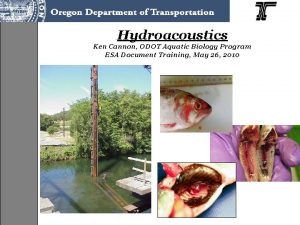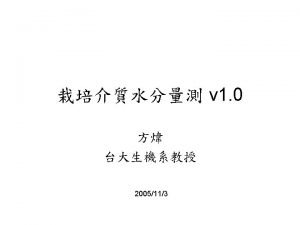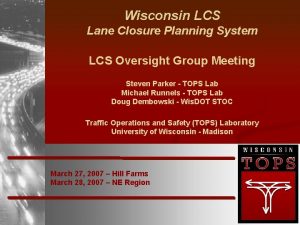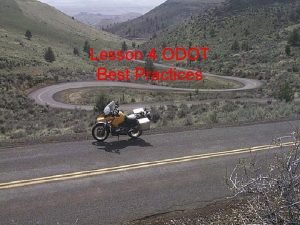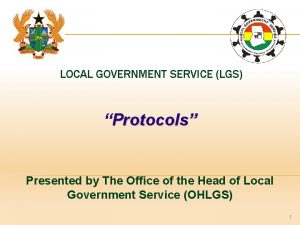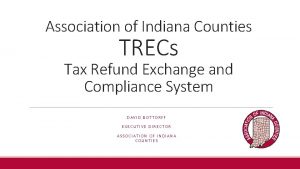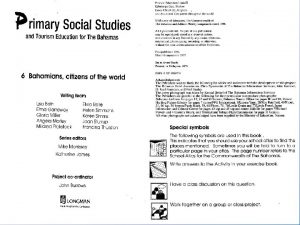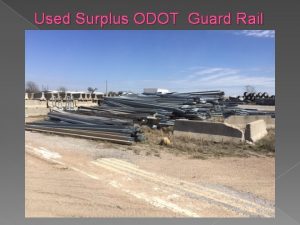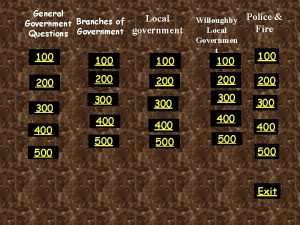Local Government Section Welcome Marty Andersen ODOT Local












































- Slides: 44

Local Government Section • Welcome Marty Andersen ODOT Local Government Section 355 Capitol Street NE, Rm. 326 Salem, Oregon 97301 Ph: 503 -986 -3640 E-mail: martin. e. andersen@odot. state. or. us

Geometric Design Guidelines for Very Low-Volume Local Roads (< 400 ADT)

Course Objective • History • Scope of Low Volume Roads • Frame work for Design Guidelines • Design Philosophy • Design Guidelines • Design examples

History • The National Cooperative Highway Research Program Studies (NCHRP) • Guideline document prepared in NCHRP Project 20 -7(108) T. R. Neuman CH 2 M Hill • Guidelines were published in 2001 • Included by reference in 2004 AASHTO

History NCHRP Reports • NCHRP Reports: – 362 Roadway Widths for Low-Traffic. Volume Roads – 383 Intersection Sight Distance – 400 Determination of Stopping Sight Distance

Scope • A very low-volume local road is a road that is functionally classified as a local road and has an ADT of 400 vpd or less • Local refers to functional class, not to type of highway agency • Both rural and urban roads included • Low-volume collectors may be included

An Important Perspective-- The Very Low Volume Local Road Operating Environment • Thousands of miles to construct, reconstruct and maintain • Environmental impacts • Local (functionally) means familiar drivers • For very low volume roads (<400 vpd) the concept of “high accident” locations is meaningless • Limited resources • Concerns about design process, design decisions and tort liability

Intent of Very Low Volume Local Road Criteria • Provide some basis for design guidance • Provide greater flexibility to designers • Reflect cost-effectiveness, with the sole focus being costs and measurable safety (crash frequency and severity

Design Guidelines • design guidelines are stratified by: – functional subclasses – design/operating speed – traffic volume

Functional Classification SUBCLASSES OF RURAL VERY LOW-VOLUME LOCAL ROADS • major access roads • minor access roads • industrial/commercial access roads • agricultural access roads • recreational and scenic roads • resource recovery roads

Functional Classification SUBCLASSES OF URBAN VERY LOW-VOLUME LOCAL ROADS • urban major access streets • urban residential streets • urban industrial/commercial access streets

Collectors • major access road • urban major access street

Design/Operating Speed • Low speed – 0 to 45 mph • High speed – 50 mph or over

Traffic Volumes • 100 veh/day or less • 100 to 250 veh/day • 250 to 400 veh/day • Consideration of Vehicles is important

Design Philosophy • Less restrictive design criteria can be used on very low-volume local roads because: – lower traffic volumes present substantially reduced opportunities for multiple-vehicle collisions – most drivers are familiar with the roadway an are less likely to be surprised by geometric elements

Design Philosophy Implied by AASHTO Criteria • Provide a “Margin of Safety” – Wide ranges in potential traffic conditions, drivers and vehicles – Reflect safety, traffic operational quality (“comfort and convenience”), constructability and maintainability – Not strictly based on cost-effectiveness • Provide consistent, minimal “quality”

New Construction vs. Existing Roads NEW CONSTRUCTION • Design to very low-volume local road criteria based on risk assessment • Designer has great flexibility in exercising judgment to deviate from numerical design criteria

New Construction vs. Existing Roads • Includes reconstruction, rehabilitation, restoration, and resurfacing • Retain current geometrics unless there is evidence of a site-specific safety problem • If there is an identified safety problem, upgrade at least to very low-volume local road criteria • There is flexibility in upgrading criteria as well

What is Evidence of a Site-Specific Safety Problem? • adverse accident history (5 to 10 years) • skid marks or roadside damage noted in field reviews • speeds higher than design speed • concerns raised by police, fire or local residents

Risk Assessment • Urban Low-speed Facilities – 1 additional crash per mile every 4 to 6 years based on proposed project is acceptable • Rural or Urban High Speed Facilities – 1 additional crash per mile every 6 to 9 years based on proposed project is acceptable

Additional risk is site specific • ‘Substandard’ radius horizontal curve • Location with ‘substandard’ clear zone • Substandard lane or shoulder width

Illustration of Risk Assessment -Horizontal Curve Radius A given curve on a roadway with 250 vpd is designed according to Green Book criteria for a design speed of 50 mph, with a central angle of 20 degrees. What is the estimated safety risk of accepting a smaller radius curve equivalent to a speed of 40 mph per Green Book criteria? Per Zegeer’s model for horizontal curves (FHWA research), the expected 5 -year crash frequency for an 50 mph curve is 0. 105; and for a 40 mph curve is 0. 135. Difference is 0. 135 - 0. 105 = 0. 03 crashes per 5 years, or 1 additional crash per 165 years of operation at 250 vpd

• • Geometric Design Criteria cross section bridge width horizontal alignment stopping sight distance intersection sight distance roadside design unpaved roads two-way single lane roads

Cross Section • New Construction Rural – Based on the functional subclass of the road – Varies from 18 to 26 feet. – Is based on total width not on lane width & shoulder – Designer has flexibility to use discretion for choosing widths – There is a table for this on page 18 of the Low volume guide book – Vehicle type needs to be considered

Cross Section New Construction Rural

Cross Section • New Construction Urban – Follows the same functional subclass except for Residential – Parking will have a greater impact on urban sections – Speed typically are lower – Designer has flexibility to use discretion for choosing widths – Urban residential is based on development density

Bridge Widths • New Construction – Bridge should be equal to roadway plus 2 feet – If shoulder is paved than match the total width – Bridges longer than 100 feet should be evaluated to determine the width – Type of vehicle should be considered – One lane bridges can be considered for <100 ADT – One lane bridges need turn outs – One lane width between 15 & 16 feet

Bridge Widths • Existing Bridges – Remain the same width unless there is a evidence of a safety problem – Replacement of existing bridge can remain the same width unless there is evidence of a safety problem – Even if there is a shift in the alignment – Should consider the vehicle types with replacement bridges

Horizontal Alignment • Radius of curves are based on friction factor, vehicle speed and super elevation • The guide uses the concept that the AASHTO method was developed for driver comfort and there is substantial safety factors built in • Radius is determined based on functional subclass, design speed and ADT < or > 250

Horizontal Alignment • Radius of curves are based on friction factor, vehicle speed and super elevation • The guide uses the concept that the AASHTO method was developed for driver comfort and there is substantial safety factors built in • Radius is determined based on functional subclass, design speed, Super elevation and ADT < or > 250

Horizontal Alignment • Guide uses a concept of reduced design speed and friction factor for selection of the radius • Reductions are from 0 to 10 MPH depending on the sub classification and ADT • Super elevation transitions are base on AASHTO Policy on Geometric Design of Highways and Streets

Horizontal Alignment (example) 55 50 AASHTO 0. 140 0. 130 925 1190

Sight Distance • Sight distance used is dependent on the ADT and risk of location • Maneuver sight distance is use to calculate for the lower volume roads with low safety risk • Low risk are locations away from intersections, narrow bridges, railway grade crossings sharp curves and steep grades.

Sight Distance • Use the design site distance chart on page 34 to determine minimums • Two curve tables one for Horizontal curves one for crest vertical curves • Sag curves are to be design from the AASHTO Policy on Geometric Design of Highways and Streets • Existing roads do not require site distance improvements unless safety problem is identified

Intersection Sight Distance • Establish clear sight triangles • Approach sight triangles and departure sight triangles • If any leg of an intersection is over 400 ADT use AASHTO Policy on Geometric Design of Highways and Streets • Traffic control methods and speed will determine the sight distance needed

Roadside Design • There are two key aspects to roadside design – Clear zone – Traffic barrier warrants • It has been found that on low volume roads it is not generally cost effective to provide clear zones or traffic barriers

Clear Zones • Provide 6 ft. or more at low cost, minimal social/environmental impacts • Provide 0 - 6 ft. where there are constraints such as cost, terrain, right of way or social/environmental impacts • Designer must use judgment and consider the conditions and existing safety problems

Barriers • Barriers are a road side obstacle • Vehicle impacts with barriers produce injures • Engineer may use judgment in the placement of barriers • Barriers should be considered where departure would likely be extremely severe

Consider Barrier?

Unpaved Roads • Crash rates are higher for unpaved roads • Crash rates increase at high volumes and there is some evidence at 300 ADT paving should be considered • Narrower unpaved roads have lower crash rates • Design speeds should generally not exceed 45 mph

Unpaved Roads • Can function find for all functional subclasses at low volumes • Geometric design needs have a through review if paving an existing unpaved road because of anticipated higher speeds

Design Examples • There are eight design examples in the back of the Guide starting on page 53 • When using this guide as the design parameters the designer should include something similar to these examples as part of the documentation

Conclusion • Very low volume roads have low safety risk even though the accident rates may be higher than other roads • Only low cost safety elements should be considered unless evidence of a problem • Designers have flexibility with in the guidelines • Considerable savings in cost and impacts result when this guide is used for low volume roads.

THANK YOU
 Odot bridge inspection manual
Odot bridge inspection manual Odot l&d volume 2
Odot l&d volume 2 Odot assetwise
Odot assetwise Isoc webmail
Isoc webmail Odot incident response
Odot incident response Tiana tozer
Tiana tozer Odot surplus equipment
Odot surplus equipment Odot ftp
Odot ftp Probe echo
Probe echo Wisdot lcs
Wisdot lcs Odot programmatic
Odot programmatic Dilbert product management
Dilbert product management Stagg chargers
Stagg chargers Characters in shiloh
Characters in shiloh Marty kay
Marty kay Marty hall java
Marty hall java We are many parts marty haugen
We are many parts marty haugen Marty
Marty Marty lobdell
Marty lobdell Anthrax history
Anthrax history Marty
Marty Marty gauvin
Marty gauvin Joe and marty are in the park playing catch
Joe and marty are in the park playing catch Marty weissman market america
Marty weissman market america Marty auer
Marty auer Marty ellingsworth
Marty ellingsworth Marty stepp linkedin
Marty stepp linkedin Marty romero
Marty romero Marty martinson
Marty martinson Pubcookie
Pubcookie Cse 373
Cse 373 National government vs federal government
National government vs federal government Wise men three clever are we
Wise men three clever are we Local government appraisal form
Local government appraisal form Oracle grants management
Oracle grants management Local government service protocols
Local government service protocols Australian access federation
Australian access federation Trecs local gov clearinghouse phone number
Trecs local gov clearinghouse phone number Commonwealth local government forum
Commonwealth local government forum Commissioner of local government
Commissioner of local government Local government investment pool organization
Local government investment pool organization Pangkat tagapagkasundo function
Pangkat tagapagkasundo function State of local government barometer
State of local government barometer Classification of local government
Classification of local government Local government finance
Local government finance
